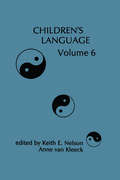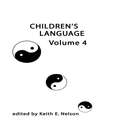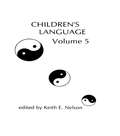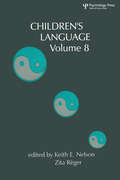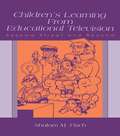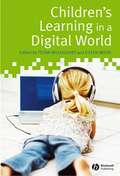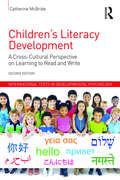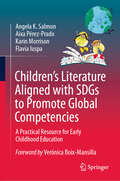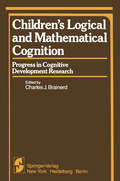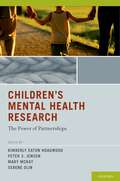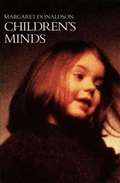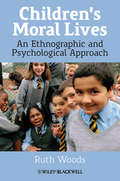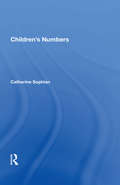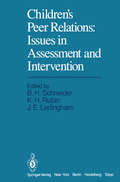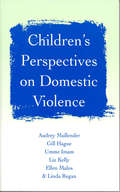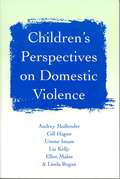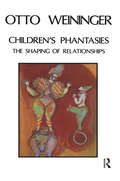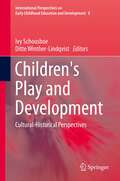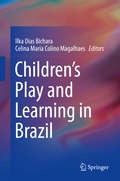- Table View
- List View
Children's Language: Volume 6 (Children's Language Series)
by K. Nelson Anne Van KleeckThis series, Children’s Language, reflects the conviction that extensive work on entirely new fronts along with a great deal of reinterpretation of old-front data will be necessary before any persuasive and truly orderly account of language development can be assembled. None of the chapters are simply reviews, and none of the volumes are " handbooks" or " reviews" or introductory texts. Rather the volumes try to capture the excitement and complexity of thinking and research at the growing, advancing edges of this broad field of children’s language. In line with these goals for the Children’s Language series the present volume includes coverage of a fairly wide range of topics and subtopics. The authors for each chapter will weave their own story and we leave to them the introduction of their main plots and the major and minor characters in their scientific stories. This is volume 6.
Children's Language: Volume 4 (Children's Language Series)
by Keith E. NelsonFirst published in 1983. Routledge is an imprint of Taylor & Francis, an informa company.
Children's Language: Volume 5 (Children's Language Series)
by Keith E. NelsonFirst published in 1985. Routledge is an imprint of Taylor & Francis, an informa company.
Children's Language: Volume 8 (Children's Language Series)
by Keith E. Nelson Zita R Zita RegerEach child is spoken to by genetic heritage and by the rich current set of interactional environments -- familial, local community, and broader cultural voices. Using past structures and paradigms of scholarship, scholars seek to understand what the child achieves in language and how. The tools available for this research are not static but evolve jointly through the sharing of information, and with each "brief moment in time" in efforts to look at children's languages "just as they are." Containing a wide range of contributions from developmental approaches to phonological ability, the lexicon, the grammar as well as conversation and sign language, this text details the interrelated research and theorizing discussed at a recent Budapest conference. The meeting of the International Association for the Study of Child Languages was particularly rich in the diversity of scholars present, which is highly appropriate because such diversity is integral to an informed study of children's language.
Children's Language: Volume 8 (Children's Language Series)
by Keith E. Nelson Zita RégerEach child is spoken to by genetic heritage and by the rich current set of interactional environments -- familial, local community, and broader cultural voices. Using past structures and paradigms of scholarship, scholars seek to understand what the child achieves in language and how. The tools available for this research are not static but evolve jointly through the sharing of information, and with each "brief moment in time" in efforts to look at children's languages "just as they are." Containing a wide range of contributions from developmental approaches to phonological ability, the lexicon, the grammar as well as conversation and sign language, this text details the interrelated research and theorizing discussed at a recent Budapest conference. The meeting of the International Association for the Study of Child Languages was particularly rich in the diversity of scholars present, which is highly appropriate because such diversity is integral to an informed study of children's language.
Children's Learning From Educational Television: Sesame Street and Beyond
by Shalom M. FischAt its best, educational television can provide children with enormous opportunities and can serve as a window to new experiences, enrich academic knowledge, enhance attitudes and motivation, and nurture social skills. This volume documents the impact of educational television in a variety of subject areas and proposes mechanisms to explain its effects. Drawing from a wide variety of research spanning several disciplines, author Shalom M. Fisch analyzes the literature on the impact of educational resources. He focuses on television programs designed for children rather than for adults, although adult literature is included when it is particularly relevant. In addition, much of the discussion concerns the effects of unaided viewing by children, rather than viewing in the context of adult-led follow-up activities. The role of parent-child co-viewing and issues relevant to the use of television in school or child care also receives consideration. This volume is intended to make the disparate literature on educational television's impact more accessible, by bringing it together into a centralized resource. To that end, the volume draws together empirical data on the impact of educational television programs--both academic and prosocial--on children's knowledge, skills, attitudes, and behavior. In addition to its emphasis on positive effects, this volume addresses a gap in the existing research literature regarding children's learning from exposure to educational television. Acknowledging that little theoretical work has been done to explain why or how these effects occur, Fisch takes a step toward correcting this situation by proposing theoretical models to explore aspects of the mental processing that underlies children's learning from educational television. With its unique perspective on children's educational television and comprehensive approach to studying the topic, this volume is required reading for scholars, researchers, and students working in the area of children and television. It offers crucial insights to scholars in developmental psychology, family studies, educational psychology, and related areas.
Children's Learning From Educational Television: Sesame Street and Beyond
by Shalom M. FischAt its best, educational television can provide children with enormous opportunities and can serve as a window to new experiences, enrich academic knowledge, enhance attitudes and motivation, and nurture social skills. This volume documents the impact of educational television in a variety of subject areas and proposes mechanisms to explain its effects. Drawing from a wide variety of research spanning several disciplines, author Shalom M. Fisch analyzes the literature on the impact of educational resources. He focuses on television programs designed for children rather than for adults, although adult literature is included when it is particularly relevant. In addition, much of the discussion concerns the effects of unaided viewing by children, rather than viewing in the context of adult-led follow-up activities. The role of parent-child co-viewing and issues relevant to the use of television in school or child care also receives consideration. This volume is intended to make the disparate literature on educational television's impact more accessible, by bringing it together into a centralized resource. To that end, the volume draws together empirical data on the impact of educational television programs--both academic and prosocial--on children's knowledge, skills, attitudes, and behavior. In addition to its emphasis on positive effects, this volume addresses a gap in the existing research literature regarding children's learning from exposure to educational television. Acknowledging that little theoretical work has been done to explain why or how these effects occur, Fisch takes a step toward correcting this situation by proposing theoretical models to explore aspects of the mental processing that underlies children's learning from educational television. With its unique perspective on children's educational television and comprehensive approach to studying the topic, this volume is required reading for scholars, researchers, and students working in the area of children and television. It offers crucial insights to scholars in developmental psychology, family studies, educational psychology, and related areas.
Children's Learning in a Digital World
by Teena Willoughby Eileen WoodChildren's Learning in a Digital World presents exciting and challenging new ideas from international scholars on the impact of computers, the Internet, and video games on children's learning. Features exciting new research which reassesses the threats posed by technology to the social, emotional, and physical development of children Examines the impact of technology in both formal and informal learning contexts, covering a range of technologies relevant to students and researchers, as well as professional educators Presents key information on the social and cultural issues that affect technology use, in addition to the impact on children’s learning Includes research from an international range of contributors
Children's Literacy Development: A Cross-Cultural Perspective on Learning to Read and Write (International Texts in Developmental Psychology)
by Catherine McBrideIn the thoroughly updated second edition of this unique book, Catherine McBride examines how the languages we know help structure the process of becoming literate. Taking an ecological and distinctively cross-cultural perspective, the book looks at reading and writing development and impairment across a range of languages, scripts, and contexts. The book covers issues including: The importance of phonological sensitivity for learning to read and to write The first units, or building blocks, of literacy learning in different scripts such as Chinese, English, Korean Hangul, Hebrew, Hindi and Arabic The role of visual processing in reading and writing skills How the latest research can inform the teaching of reading An overview of our understanding of dyslexia, including recent neuroscientific research The developmental challenges in becoming biliterate What is special about writing for beginners and later for comprehensive writing Basics of reading comprehension Children’s Literacy Development, Second Edition is a timely and important contribution to our understanding of literacy around the world. Written by an eminent scholar in the field, it is the only book available that provides an overview of how children learn to read and write in different languages, and will be essential reading for all students of Developmental Psychology, Educational Psychology, Psycholinguistics and Speech Therapy.
Children's Literacy Development: A Cross-Cultural Perspective on Learning to Read and Write (International Texts in Developmental Psychology)
by Catherine McBrideIn the thoroughly updated second edition of this unique book, Catherine McBride examines how the languages we know help structure the process of becoming literate. Taking an ecological and distinctively cross-cultural perspective, the book looks at reading and writing development and impairment across a range of languages, scripts, and contexts. The book covers issues including: The importance of phonological sensitivity for learning to read and to write The first units, or building blocks, of literacy learning in different scripts such as Chinese, English, Korean Hangul, Hebrew, Hindi and Arabic The role of visual processing in reading and writing skills How the latest research can inform the teaching of reading An overview of our understanding of dyslexia, including recent neuroscientific research The developmental challenges in becoming biliterate What is special about writing for beginners and later for comprehensive writing Basics of reading comprehension Children’s Literacy Development, Second Edition is a timely and important contribution to our understanding of literacy around the world. Written by an eminent scholar in the field, it is the only book available that provides an overview of how children learn to read and write in different languages, and will be essential reading for all students of Developmental Psychology, Educational Psychology, Psycholinguistics and Speech Therapy.
Children’s Literature Aligned with SDGs to Promote Global Competencies: A Practical Resource for Early Childhood Education
by Angela K. Salmon Aixa Pérez-Prado Karin Morrison Flavia IuspaThis book presents children’s literature as a platform for learning and helping young readers develop the knowledge, skills, and attitudes needed to thrive in an interconnected and diverse global society. It draws from various theoretical frameworks and research findings to implement critical literacy and culturally responsive teaching in the meaning-making process.The book focuses on global competencies and Sustainable Development Goals (SDGs) as intertwined concepts that work together to foster a more sustainable, inclusive, and equitable world. Developing global competencies empowers children and communities to actively participate in achieving the SDGs and addressing the pressing challenges of our time. The authors set high expectations on children as actors in transforming society. To facilitate this, the book offers an overview of child development theories as a foundation for designing developmentally appropriate practices to extend children’s books toward deep thinking and understanding. The book includes sample lessons that use cutting-edge research-based pedagogies and tools such as visible thinking routines and other approaches. Those lessons also help readers identify the Habits of Mind (HOM) children can develop by listening to and discussing stories. The HOM are attributes of good problem-finders and problem-solvers needed when confronting complex issues. The book provides resources and sample lessons that implement different thinking strategies to engage children in questioning and analyzing what they read, making them more critical. This is how children deeply understand the world and their role in creating positive change. The book aims to cultivate change-makers and global citizens through stories. It offers innovative approaches, including online learning options in accessible and engaging ways to help children think globally and act locally‘Through the power of children’s literature, this book serves a larger agenda: To build a more thoughtful world for future generations. By caring for and learning from one another through suggested activities in this book, they will share the riches and resources from across the world. As children learn about the promise of actions toward the UN Sustainable Goals, they can imagine living in an interdependent learning community where all people continually searching for ways to trust each other, learn together, and grow toward greater intelligence.’ Arthur Costa and Bena Kallick, Co-Founders and Directors of The Institute for Habits of Mind
Children’s Logical and Mathematical Cognition: Progress in Cognitive Development Research (Springer Series in Cognitive Development)
by Charles J. BrainerdFor some time now, the study of cognitive development has been far and away the most active discipline within developmental psychology. Although there would be much disagreement as to the exact proportion of papers published in developmen tal journals that could be considered cognitive, 50% seems like a conservative estimate. Hence, a series of scholarly books to be devoted to work in cognitive development is especially appropriate at this time. The Springer Series in Cognitive Development contains two basic types of books, namely, edited collections of original chapters by several authors, and original volumes written by one author or a small group of authors. The flagship for the Springer Series will be a serial publication of the "advances" type, carrying the subtitle Progress in Cognitive Development Research. Each volume in the Progress sequence will be strongly thematic, in that it will be limited to some well-defined domain of cognitive-developmental research (e. g. , logical and mathematical de velopment, semantic development). All Progress volumes will be edited collec tions. Editors of such collections, upon consultation with the Series Editor, may elect to have their books published either as contributions to the Progress sequence or as separate volumes. All books written by one author or a small group of authors will be published as separate volumes within the series. A fairly broad definition of cognitive development is being used in the selection of books for this series.
Children's Mental Health Research: The Power of Partnerships
by Kimberly Eaton Hoagwood Peter S. Jensen Mary McKay Serene OlinResearch in children's mental health lags behind research for adults in part because it is intrinsically context-bound. Children are embedded in families, in schools, and in communities who have responsibility for their care. Making research findings useful and ensuring that they are applied to improve the lives of children and families requires attention to these contexts. This entails a process of collaboration with many partners--teachers, nurses, healthcare providers, church leaders, neighborhood group directors, and other community leaders. The process of collaboration in children's mental health is complicated but the products that it yields have the potential to benefit both children and families. This volume, with the toolkit and casebook that it contains, distills the process of collaboration into manageable steps, and provides concrete examples of how researchers have addressed specific challenges. The premise of the book is that collaborative research, in contrast to traditional research paradigms, will yield findings that are more ethical, valid, and useful. Highlighting the transformation of science from ivory-tower theories to action-oriented practices, the editors offer practical advice for researchers and practitioners interested in using data to inform and transform children's mental health. Concrete examples of projects that have involved community leaders and researchers provide an insider's guide to conducting successful collaborations that can yield better results than traditional top-down research paradigms.
Children's Minds (PDF)
by Margaret DonaldsonMargaret Donaldson's seminal work on child development, first published in 1978, has become a classic inquiry into the nature of human thought. In this concise and brilliantly readable book, Margaret Donaldson shows that context is key when it comes to the development of language and thought, and how the right support can ensure children are skilled in these areas before they even start school. She revisits earlier theories of child development, notably those of Jean Piaget, to expose flaws in the accepted wisdom on child psychology and to suggest a range of new strategies to help children combat difficulties. As wise and perceptive today as it was when it first appeared, Margaret Donaldson#65533;#65533;e#65533;(tm)s bestselling work is essential reading for anyone interested in child development and child psychology.
Children's Moral Lives: An Ethnographic and Psychological Approach
by Ruth WoodsChildren’s Moral Lives makes use of case studies, observation, interviews and questionnaires to offer a fascinating, behind-the-scenes view of children’s school lives and the complex moral issues and disputes they routinely negotiate The first ethnography of childhood to focus on children’s morality in the peer group Case studies shed light on the psychological, social and cultural processes by which children and adults reach starkly different moral judgments of the same situations Combines qualitative insights and quantitative data into recommendations for practice
Children's Moral Lives: An Ethnographic and Psychological Approach
by Ruth WoodsChildren’s Moral Lives makes use of case studies, observation, interviews and questionnaires to offer a fascinating, behind-the-scenes view of children’s school lives and the complex moral issues and disputes they routinely negotiate The first ethnography of childhood to focus on children’s morality in the peer group Case studies shed light on the psychological, social and cultural processes by which children and adults reach starkly different moral judgments of the same situations Combines qualitative insights and quantitative data into recommendations for practice
Children's Numbers
by Catherine SophianSynthesizing research on numerical development, the book explores the implications for instruction, drawing upon the ideas of Piaget, Vygotsky, and several contemporary cognitive-developmental theorists. The text is intended for use in undergraduate and graduate-level courses in developmental psychology and education. Children’s developing underst
Children's Numbers
by Catherine SophianSynthesizing research on numerical development, the book explores the implications for instruction, drawing upon the ideas of Piaget, Vygotsky, and several contemporary cognitive-developmental theorists. The text is intended for use in undergraduate and graduate-level courses in developmental psychology and education. Children’s developing underst
Children’s Peer Relations: Issues in Assessment and Intervention
by Jane E. Ledingham Kenneth H. Rubin Barry H. SchneiderWillard W. Hartup This volume amounts to an anniversary collection: It was 50 years ago that Lois Jack (1934) published the findings from what most investigators consider to be the first intervention study in this area. The experiment (later replicated and extended by Marjorie Page, 1936, and Gertrude Chittenden, 1942) concerned ascendant behavior in preschool children, which was defined to include: (a) The pursuit of one's own purposes against interference and (b) directing the behavior of others. Individual differences in ascendance were assumed to have some stability across time and, hence, to be important in personality development. But ascendance variations were also viewed as a function of the immediate situation. Among the conditions assumed to determine ascendance were "the individual's status in the group as expressed in others' attitudes toward him, his conception of these attitudes, and his previously formed social habits" (Jack, 1934, p. 10). Dr. Jack's main interest was to show that nonascendant children, identified on the basis of observations in the laboratory with another child, were different from their more ascendant companions in one important respect: They lacked self confidence. And, having demonstrated that, Dr. Jack devised a procedure for teaching the knowledge and skill to nonascendant children that the play materials required. She guessed, correctly, that this training would bring about an increase in the ascendance scores of these children.
Children's Perspectives on Domestic Violence
by Gill Hague Linda Regan Ms Ellen Malos Ms Liz Kelly Ms Umme F Imam Professor Audrey Mullender`The research methodology and the problems encountered when studying a subject such as domestic violence, coupled with the ethical problems of researching with children, are discussed at length in the book. This gives a good insight into the intricacies of conducting such a research study. The research looked not only at children who were known to have direct contact with domestic violence, but also what children in general thought and felt about domestic violence. The presentation of the findings, both in tabular and narrative form, was well presented' - Accident and Emergency Nursing Journal `This book offers accessible and interesting reading. It is well written as one would expect from these authors.... There are a lot of pointers for the way forward in terms of both policy and practice. This is likely to become a seminal text' - Research Policy and Planning 'This is a useful and challenging read for all of us who seek to work effectively and ethically in this complex area of practice' - Professional Social Work `Just looking at the authors of this book tells the reader that they are about to embark on a pioneering piece of academic research... a comprehensive and authoritative piece of work' - Domestic Abuse Quarterly `A vital tool for all those working with children' - ChildRight 'Written in a lucid style and is easy to read… it is essential reading for all students in social work undergraduate courses and also in post-qualifying courses on child welfare and protection. In addition professionals who are directly working in the area of child protection, schools and criminal justice settings would find this book informative and useful in understanding what children and young people want, and need, in relation to living in domestic violence situations' - Child and Family Social Work 'This book is powerfully written and is essential reading for professional working with and supporting abused women and their children. Its groundbreaking focus on children's experiences adds much to our understanding of the complexities of domestic violence' - Journal of Family Studies 'A treasure-chest of rich, diverse and powerful extracts from children and young people… in particular the material presented on different coping strategies used by children who have experienced domestic violence is an important contribution to an area about which very little is known' - Adoption and Fostering Journal How do children who live with domestic violence cope? How do they make sense of their experiences? Do they receive the right sort of help from formal and informal sources? Drawing on the newest research designed to hear the voices of children and young people, this important book examines children's experiences and perspectives on living with domestic violence. The authors explore: - the effect of domestic violence on children - what children say would help them most in coping with domestic violence - the advice children would offer other children who find themselves in similar circumstances, their mothers and the helping professions. This accessible book written for students, their teachers, researchers and all those working with children - across social work, health, child psychology and psychiatry, the law and education - will provide a vital insight into children's own perspectives on domestic violence.
Children's Perspectives on Domestic Violence (PDF)
by Linda Regan Gill Hague Ms Ellen Malos Ms Liz Kelly Ms Umme F Imam Professor Audrey Mullender`The research methodology and the problems encountered when studying a subject such as domestic violence, coupled with the ethical problems of researching with children, are discussed at length in the book. This gives a good insight into the intricacies of conducting such a research study. The research looked not only at children who were known to have direct contact with domestic violence, but also what children in general thought and felt about domestic violence. The presentation of the findings, both in tabular and narrative form, was well presented' - Accident and Emergency Nursing Journal `This book offers accessible and interesting reading. It is well written as one would expect from these authors. . . . There are a lot of pointers for the way forward in terms of both policy and practice. This is likely to become a seminal text' - Research Policy and Planning 'This is a useful and challenging read for all of us who seek to work effectively and ethically in this complex area of practice' - Professional Social Work `Just looking at the authors of this book tells the reader that they are about to embark on a pioneering piece of academic research. . . a comprehensive and authoritative piece of work' - Domestic Abuse Quarterly `A vital tool for all those working with children' - ChildRight 'Written in a lucid style and is easy to read. . . it is essential reading for all students in social work undergraduate courses and also in post-qualifying courses on child welfare and protection. In addition professionals who are directly working in the area of child protection, schools and criminal justice settings would find this book informative and useful in understanding what children and young people want, and need, in relation to living in domestic violence situations' - Child and Family Social Work 'This book is powerfully written and is essential reading for professional working with and supporting abused women and their children. Its groundbreaking focus on children's experiences adds much to our understanding of the complexities of domestic violence' - Journal of Family Studies 'A treasure-chest of rich, diverse and powerful extracts from children and young people. . . in particular the material presented on different coping strategies used by children who have experienced domestic violence is an important contribution to an area about which very little is known' - Adoption and Fostering Journal How do children who live with domestic violence cope? How do they make sense of their experiences? Do they receive the right sort of help from formal and informal sources? Drawing on the newest research designed to hear the voices of children and young people, this important book examines children's experiences and perspectives on living with domestic violence. The authors explore: - the effect of domestic violence on children - what children say would help them most in coping with domestic violence - the advice children would offer other children who find themselves in similar circumstances, their mothers and the helping professions. This accessible book written for students, their teachers, researchers and all those working with children - across social work, health, child psychology and psychiatry, the law and education - will provide a vital insight into children's own perspectives on domestic violence.
Children's Phantasies: The Shaping of Relationships
by Otto WeiningerOtto Weininger illustrates the manifestations of unconscious phantasy in children - normal, neurotic or psychotic - in various settings such as playgroups, ordinary schools or special schools for disturbed children, the family milieu or play therapy. He uses Melanie Klein's developmental theory and shows the evolutions of phantasies in their content, in the way they are symbolizes, and their functioning in terms of the child's evolution from the paranoid-schizoid position to the depressive position and Oedipus complex.
Children's Phantasies: The Shaping of Relationships
by Otto WeiningerOtto Weininger illustrates the manifestations of unconscious phantasy in children - normal, neurotic or psychotic - in various settings such as playgroups, ordinary schools or special schools for disturbed children, the family milieu or play therapy. He uses Melanie Klein's developmental theory and shows the evolutions of phantasies in their content, in the way they are symbolizes, and their functioning in terms of the child's evolution from the paranoid-schizoid position to the depressive position and Oedipus complex.
Children's Play and Development: Cultural-Historical Perspectives (International Perspectives on Early Childhood Education and Development #8)
by Ivy Schousboe and Ditte Winther-LindqvistThis book provides new theoretical insights to our understanding of play as a cultural activity. All chapters address play and playful activities from a cultural-historical theoretical approach by re-addressing central claims and concepts in the theory and providing new models and understandings of the phenomenon of play within the framework of cultural historical theory. Empirical studies cover a wide range of institutional settings: preschool, school, home, leisure time, and in various social relations (with peers, professionals and parents) in different parts of the world (Europe, Australia, South America and North America). Common to all chapters is a goal of throwing new light on the phenomenon of playing within a theoretical framework of cultural-historical theory. Play as a cultural, collective, social, personal, pedagogical and contextual activity is addressed with reference to central concepts in relation to development and learning. Concepts and phenomena related to ZPD, the imaginary situation, rules, language play, collective imagining, spheres of realities of play, virtual realities, social identity and pedagogical environments are presented and discussed in order to bring the cultural-historical theoretical approach into play with contemporary historical issues. Essential as a must read to any scholar and student engaged with understanding play in relation to human development, cultural historical theory and early childhood education.
Children's Play and Learning in Brazil
by Ilka Dias Bichara Celina Maria MagalhaesThis book presents for the first time in English language an overview of the research done in Brazil in the field of studies of children’s play. The volume brings together contributions from researchers of the Working Group Toy, Education and Health, of the Brazilian National Association of Research and Graduate Studies in Psychology (ANPEPP), including empirical studies and literature reviews about indigenous children, riverside communities, urban children in situation of social vulnerability, projects of early childhood education and the ludic possibilities of digital technologies. It aims to show the cultural diversity of Brazil expressed in its children’s play, providing valuable resources for international researchers of play interested in intercultural studies.
